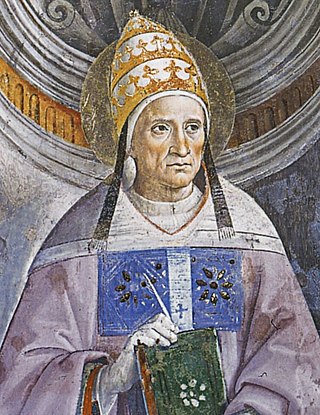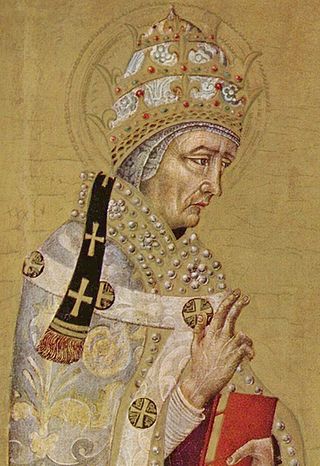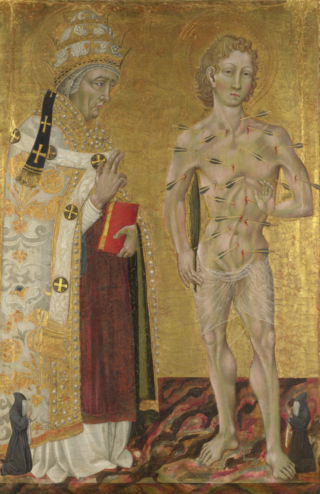Related Research Articles

Marcus Aurelius Severus Alexander, also known as Alexander Severus, was Roman emperor from 222 until 235. The last emperor from the Severan dynasty, he succeeded his slain cousin Elagabalus in 222, at the age of 13. Alexander himself was eventually assassinated, and his death marked the beginning of the events of the Crisis of the Third Century, which included nearly fifty years of civil war, foreign invasion, and the collapse of the monetary economy.

Pope Anterus was the bishop of Rome from 21 November 235 until his death on 3 January 236.

The Severan dynasty, sometimes called the Septimian dynasty, was an Ancient Roman imperial dynasty that ruled the Roman Empire between 193 and 235, during the Roman imperial period. The dynasty was founded by the emperor Septimius Severus, who rose to power after the Year of the Five Emperors as the victor of the civil war of 193–197, and his wife, Julia Domna. After the short reigns and assassinations of their two sons, Caracalla and Geta, who succeeded their father in the government of the empire, Julia Domna's relatives themselves assumed power by raising Elagabalus and then Severus Alexander to the imperial office.
6 was a common year starting on Friday of the Julian calendar. In the Roman Empire, it was known as the Year of the Consulship of Lepidus and Lucius Arruntius. The denomination "AD 6" for this year has been used since the early medieval period, when the Anno Domini calendar era became the prevalent method in Europe for naming years.
The 150s decade ran from January 1, 150, to December 31, 159.

Year 236 (CCXXXVI) was a leap year starting on Friday of the Julian calendar. At the time, it was known as the Year of the Consulship of Verus and Africanus. The denomination 236 for this year has been used since the early medieval period, when the Anno Domini calendar era became the prevalent method in Europe for naming years.
The 230s decade ran from January 1, 230, to December 31, 239.
Year 238 (CCXXXVIII) was a common year starting on Monday of the Julian calendar. At the time, it was known as the Year of the Consulship of Pius and Pontianus. The denomination 238 for this year has been used since the early medieval period, when the Anno Domini calendar era became the prevalent method in Europe for naming years.
Year 173 (CLXXIII) was a common year starting on Thursday of the Julian calendar. At the time, it was known as the Year of the Consulship of Severus and Pompeianus. The denomination 173 for this year has been used since the early medieval period, when the Anno Domini calendar era became the prevalent method in Europe for naming years.

Pope Pontian was the bishop of Rome from 21 July 230 to 28 September 235. In 235, during the persecution of Christians in the reign of the Emperor Maximinus Thrax, Pontian was arrested and sent to the island of Sardinia.

Pope Fabian was the bishop of Rome from 10 January 236 until his death on 20 January 250, succeeding Anterus. A dove is said to have descended on his head to mark him as the Holy Spirit's unexpected choice to become the next pope. He was succeeded by Cornelius.

Hippolytus of Rome was a Bishop of Rome and one of the most important second-third century Christian theologians, whose provenance, identity and corpus remain elusive to scholars and historians. Suggested communities include Rome, Palestine, Egypt, Anatolia and other regions of the Middle East. The best historians of literature in the ancient church, including Eusebius of Caesarea and Jerome, openly confess they cannot name where Hippolytus the biblical commentator and theologian served in leadership. They had read his works but did not possess evidence of his community. Photios I of Constantinople describes him in his Bibliotheca as a disciple of Irenaeus, who was said to be a disciple of Polycarp, and from the context of this passage it is supposed that he suggested that Hippolytus so styled himself. This assertion is doubtful. One older theory asserts he came into conflict with the popes of his time and seems to have headed a schismatic group as a rival to the bishop of Rome, thus becoming an antipope. In this view, he opposed the Roman Popes who softened the penitential system to accommodate the large number of new pagan converts. However, he was reconciled to the Church before he died as a martyr.

The gens Julia was one of the most prominent patrician families in ancient Rome. Members of the gens attained the highest dignities of the state in the earliest times of the Republic. The first of the family to obtain the consulship was Gaius Julius Iulus in 489 BC. The gens is perhaps best known, however, for Gaius Julius Caesar, the dictator and grand uncle of the emperor Augustus, through whom the name was passed to the so-called Julio-Claudian dynasty of the first century AD. The nomen Julius became very common in imperial times, as the descendants of persons enrolled as citizens under the early emperors began to make their mark in history.

Julia Maesa was a member of the Severan dynasty of the Roman Empire who was the grandmother of emperors Elagabalus and Severus Alexander, elder sister of empress Julia Domna, and mother of Julia Soaemias and Julia Mamaea. She wielded influence during the reigns of her grandsons as Augusta of the Empire from 218 to her death, especially on their elevation to emperors.

Julia Avita Mamaea or Julia Mamaea was a Christian Syrian noble woman and member of the Severan dynasty. She was the mother of Roman emperor Alexander Severus and remained one of his chief advisors throughout his reign. She was killed in 235 by rebel soldiers alongside her son.

Titius Quartinus was a Roman usurper.
Marcus Julius Gessius Marcianus also known as Gessius Marcianus was a Syrian Roman aristocrat. He was the second husband of Julia Avita Mamaea and step-father of the future emperor Severus Alexander.

Maximinus Thrax was a Roman emperor from 235 to 238. Born of Thracian origin – giving the nickname "Thrax" – he rose up through the military ranks, ultimately holding high command in the army of the Rhine under Emperor Severus Alexander. After Severus was murdered in 235, he was proclaimed emperor by the army, beginning the Crisis of the Third Century.
References
- 1 2 Monumenta Graeca et Romana: Mutilation and transformation : damnatio memoriae and Roman imperial portraiture. Brill Publishers. January 1, 2004. p. 157. ISBN 90-04-13577-4.
- ↑ Kirsch, Johann Peter (1911). "Pope St. Pontian" in The Catholic Encyclopedia. Vol. 12. New York: Robert Appleton Company.
- ↑ Shahan, Thomas (1907). "Pope St. Anterus" in The Catholic Encyclopedia. Vol. 1. New York: Robert Appleton Company.
- ↑ Xiong, Victor Cunrui (2009). Historical Dictionary of Medieval China. Rowman & Littlefield. p. 484. ISBN 9780810860537.
- 1 2 Rafe de Crespigny (2006). A Biographical Dictionary of Later Han to the Three Kingdoms. Brill. pp. 42, 279. ISBN 9789047411840.
- ↑ "Cassius Dio". Encyclopædia Britannica. January 1, 2024. Retrieved February 24, 2024.
- ↑ Ancient and Early Medieval Chinese Literature. Vol. 1. BRILL. 2010. p. 383. ISBN 9789047444664.
- ↑ "Maximinus Thrax". De Imperatoribus Romanis . Archived from the original on June 9, 2019. Retrieved March 12, 2022.